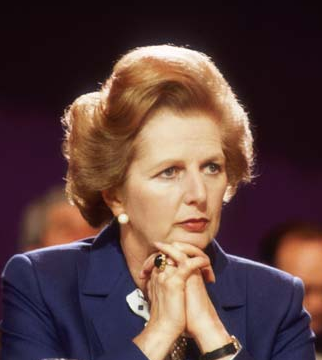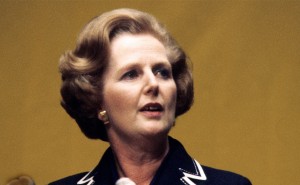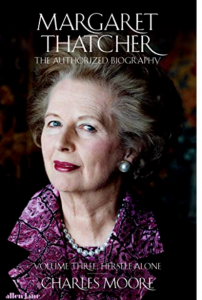
Fall of Thatcher, her changes to divide Britain


A conspiracy removed Margaret Thatcher states Charles Moore almost in slow motion.
The volume starts in 1987 with Thatcher’s third general election victory covers her fall from power in 1990, and her subsequent decline. In the previous two volumes Moore has worked 20 years covering her childhood and early years, then her first victory of 1979 and the desperate battles of the first years of her government.
Two successive chancellors were locked in a battle with her over how to manage inflation with three successive foreign secretaries opposing her approach to Europe. Her critical role in partnership with Ronald Regan in the ending of the cold war, and how she managed to marginalise herself during the final climatic events by her opposition not only her own government’s stated policy but to that of the US as well as the reunification of Germany.
The surprising thing is that she came within two votes of survival in the first round of the fatal leadership challenge by Michael Heseltine. If her civil service staff of Charles Powell and Bernard Ingham had been allowed to run the final campaign, instead of the incompetents who did run it, she would have won.
In November 1990, when she fell and why Mrs Thatcher found herself, to her total incomprehension fighting for her political life. The root cause is why Thatcher could not find a chancellor with whom she could agree? Or a foreign secretary? Why was she, far more than Neil Kinnock , Labour’s leader of opposition to the crucial central policies of her own government on the management of the economy and on Europe?
Moore reveals the answer by explaining her strengths and weaknesses. In the first periods of her government she articulated very widespread national feelings and represented the zeitgeist when she said there was no alternative to confrontation with politicised trade unions. She ended the soft corporatism which had brought sloppy monopolist companies in both public and private sectors far too close into the state.
Thatcher put into action an extreme deep seated desire for change, widely shared and saw it through. Then there was the victory in the Falklands, to which no other of our politicians of the time could have led us. Her capacity instinctively to understand what a great swath of the British people wanted done, and then the courage to do it when other didn’t dare. People grumbled about all things, but didn’t like the sound of alternatives. They like the sound of doing away with the domestic rates , but not at all with the alternative, the community charge or poll tax.
She understood the widespread grumbling about Europe and grumbled away with the best of them, but she either could not or would not change her own government’s policy on it. “the Iron Lady is not for turning”.
She made it impossible to conduct that policy effectively, but could not find the ruthlessness or the political power base necessary to change it. So too, with Chancellor Nigel Lawson and Europe’s Exchange Rate Mechanism, she made it impossible for him to conduct what was supposed to be government policy, but could not find the ruthlessness to sack him nor the authority to generate a different policy. Thus his resignation, when it came over what seemed a trivial matter, was wholly incomprehensible to the outside world.
In her tragic final decline, she did not always choose her colleagues well, but she chose well when she appointed Moore to his colossal task.
Margaret Thatcher: The Authorised Biography, Volume Three: Herself Alone by Charles Moore, Allen Lane £35, 1, 072 pages.
